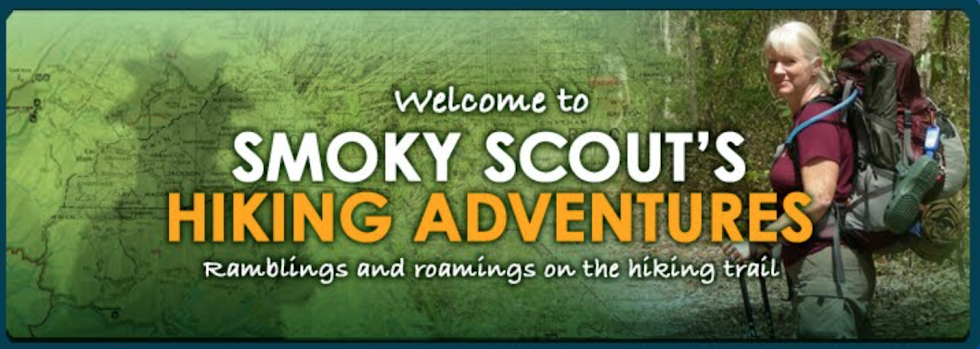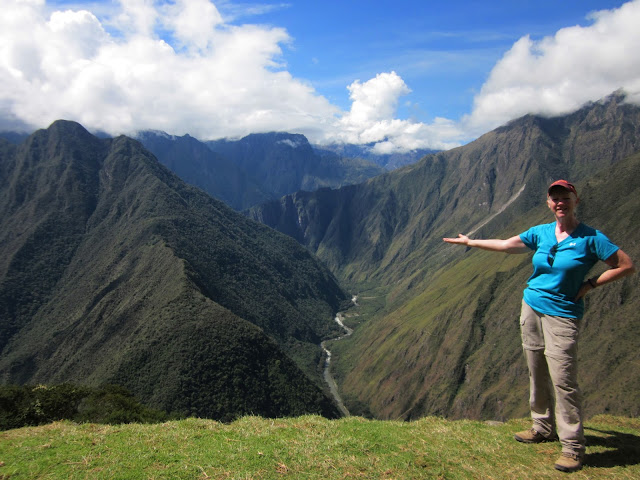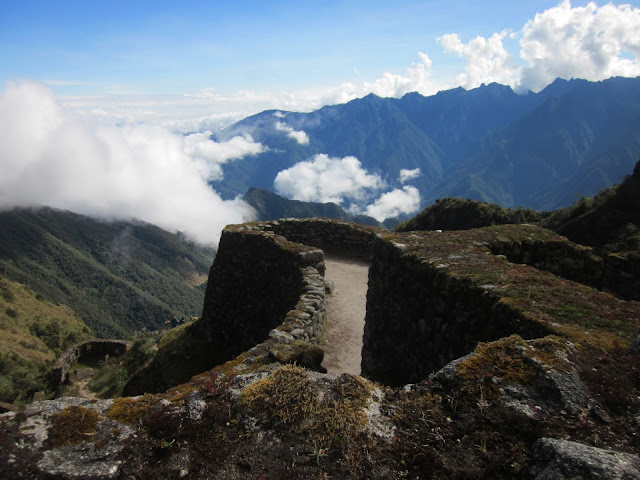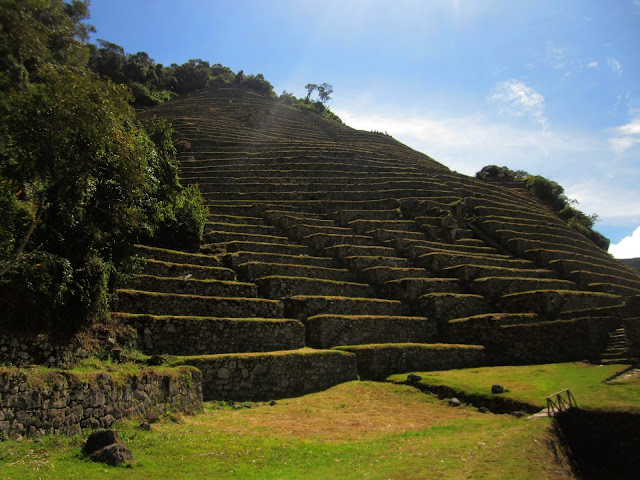Adventures in Peru – 6/12/14 – Land of Enchantment - Chaquiqocha to Wiñay Wayna – 9km
The day starts off luxuriously, sleeping in until nearly 6:00 a.m. My cup of coca tea warms my hands this morning, temp seems to be in the high 40’s. We will only hike until lunchtime and then…oh my gosh I can hardly contain myself…we have the afternoon off. I feel a nap coming on.
Breakfast? My
appetite is still missing in action, but I try to eat some toast and yogurt with
fruit. There is also an egg-and-diced-veggie
scramble. It is not my habit to eat
breakfast at home until after I’ve been up for a couple of hours and had a
workout. I carry a couple of Clif bars
to try to nibble on today. As part of
packing up, we remember that our sleeping bags and mats and other stuff goes
back in our own backpacks today.
Looking back at camp
Looking ahead
Vamos! Still at 12,000
feet, the slightest upward incline is torture.
How long do you have to live at high altitude to become acclimated? Soon we arrive at the Inca Tunnel, a
12-meter rock tunnel with steep steps (are there any other kind?), fun to hoot
and holler as we descend.
Andy at the bottom of the tunnel
Of course we have more climbing up to the third
pass of the Inca Trail. We
need a rest at the top, but first let’s pose on top of this big rock.
Our shadows (aren’t we clever?)
Just below the pass is our reward: the ancient site of Phuytupatamarka, “City
Above the Clouds.” The structure of this
site is unusual, a pyramid of seven terraces linked by a straight
stairway. On one side is an intricate
series of ceremonial baths connected by water channels. Archeologists opine that these were probably
not used for washing in but intended for use in the ritual worship of
water. It is the best example we’ve seen
so far of how the Incans captured and distributed water. The site probably supported hundreds of
people.
Temple of the Sun at Phuytupatamarka
Below the site we step onto a spiral staircase, each step
carved out of the bedrock. One huge
boulder has more than 30 steps cut into it.
We wind down into the cloud forest, a lovely wooded respite, and tiny
flowers seem to drip from the sides of the mountain.
Time for a breather and a look at the view, view, view
What do I see? Another Inca site called Intipata. Yes, it is downhill. Every single step on this trek is a life lesson. After 2,400 feet downhill, my thighs are quivering. Intipata is on a side trail, but after seeing it intricately carved into the mountainside, there is no question whether we want to make the diversion.
Intipata means “Sunny Slope” or “The Place of the Sun.” It consists of nearly 50 terraces and a few
residential buildings. The absence of
plazas or gathering spaces, religious structures or fortifications leads to the
conclusion that this was primarily an agricultural settlement, but because of
its strategic position on the mountain mid-way between the Urabamba River and
Machu Picchu and its panoramic view into the valley, it also could have served as
a signaling site. It is astounding to
think that all of these places languished for hundreds of years and were only
discovered within the last century.
We walk along one of the terraces to where the curve widens. Dropping our packs, we sit down and relax as Washington gives us background on the site. The sun is shining, the air is a perfect temperature, and the view is surreal.
I
feel weightless as I lay down by the edge and look out across mountains that
cannot be contained.
The Urabamba River is at my feet.
The Urabamba River is at my feet.
Washington patiently accepts each of our cameras and takes
group photos for us.
Another group shows up and their guide takes another round
of photos with Washington included.
Terraces at Intipata
Our campsite is only a couple of kilometers and 700 feet descent from Intipata. It is called Wiñay Wayna. The campsite once had a simple hostel but the building fell into disrepair and is no longer viable. (I’m kind of glad because that means fewer people.) Washington explains that late in the afternoon we have the opportunity to see the ancient Inca site of the same name.
Our tents are set up on a narrow terrace, barely room to walk from one to the next. The baños are on a lower level, much too far to walk after dark with cramping thigh muscles. We will find another solution for that.
Lunch? I can’t
remember what is on the menu and I eat a minimal amount. More important to me is siesta time. Cathy and I enjoy our view.
The World Cup (soccer, y’all) kicks off this afternoon with
the opening match between Brazil and Croatia.
What’s a fan to do up here in the Andes?
Miracle of miracles, an Inca Trail ranger’s house is nearby and he has a
satellite connection. For only one sol
you can grab a space and cheer for…Brazil, of course. Cathy, Andy, Sergi, Cami and Francine join
the chaos, but I am lying on my sleeping bag and I cannot move a muscle. Chris and Maria are comatose in their tents on
either side of me. I hear murmuring
voices as I drift in and out and am so very grateful for these few hours of
inertia. I have not felt rested since I
left home.
Everyone returns from the soccer match and Washington
gathers us together to visit Wiñay Wayna.
For a moment I consider staying behind to continue my beauty rest, but
it is a 15-minute walk, and now I am catching on that the Inca sites are
increasingly larger and more elaborate as we get closer to Machu Picchu. I think we are about to see something
grand. Yes, yes, we are.
Wiñay Wayna means “Forever Young.” It is the most intricate and awe-inspiring site we have seen on our trek. The complex is divided into two sections, with a temple and houses at the top and more rustic structures below, and terraces between and extending out the sides. The two sections are linked by a staircase and a set of ten ceremonial baths as the water descends down the terraces (the water flows from a spring that originates at Phuytupatamarka). Several springs carry water to various stone baths located at different levels throughout Wiñay Wayna.
Llamas are good at posing for photos. They roam the Inca sites as part of the
landscaping crew.
Washington is also a good poser as he stands next to llama
poop.
The Urabamba River through a doorway at Wiñay Wayna.
In the late afternoon there are few people at Wiñay Wayna. We feel a reverence here, talking in low
voices, and in the peaceful quiet I can hear water from three different places: the Urabamba River crashing below, a
beautiful waterfall cascading nearby, and a tiny trickling stream from the cistern
system. As the light fades, we head back
to camp.
In the dining tent snacks await, more popcorn and “flat
wontons” which look like fried tortilla strips.
The soup is a chicken and vegetable broth, a salad of tomatoes, lettuce
and zucchini cut in thin strips, beef au jus, and stuffed peppers, which I
avoid. Apparently some of the peppers are
hotter than others because Sergi takes a
bite and begins coughing and panting, “Agua! Agua!” He takes a lot of teasing for not being able
to handle the peppers. As a special treat, the cook presents us with a cake for
good luck, and it is delicioso, vanilla flavored, dense, not too sweet. We cut it in small pieces to share with the
porters, too.
Speaking of porters, Washington explains that it is
customary to tip the porters and our cook (we knew about this ahead of time)
and he leaves us after dinner to put our heads together and pool our
money. Cami is very adept at converting
dollars to soles and is adamant that we not overtip, explaining that being too
generous sets an expectation that may not be met at other times. Next we have a formal ceremony with the
porters where we thank them for their service and present them with their
gifts. We will see them only briefly in
the morning, as they must pack up camp and hike down a different trail than we
are taking so that they can catch the 5:45 a.m. train leaving the town of Aguas
Calientes.
That means we must get up and leave camp by 4:00 a.m. What???
Hard to get to sleep knowing that, plus the anticipation of reaching our
destination tomorrow. This journey has
been difficult, exhausting, and stressful, but the rewards thus far have been
worth the effort and beyond my expectations.
After all we have seen, what will Machu Picchu be like?
I have been wearing my favorite Liberty hat during the cool
mornings and evenings of our trek and Nestor has expressed a liking for
it. Whenever he sees me he points to my
hat and his and indicates an exchange: me and my friend with his big-hearted
smile.
“Since there is nothing so well worth having as friends,
never lose a chance to make them.”
~Francesco Guicciardini





















































